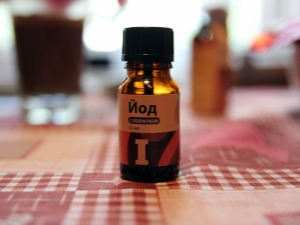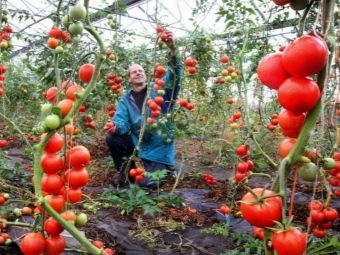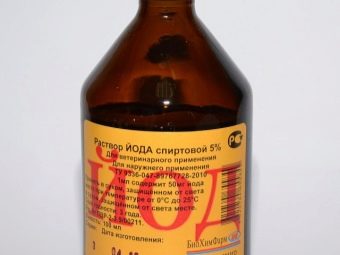Iodine for tomatoes: what is needed and how to fertilize?

The solution based on iodine can make a useful and effective dressing for tomatoes at different stages of its development.In addition, a similar composition will help to cope with infections, will act as a prophylactic agent. The main thing is to prepare the solution correctly and treat the plant, otherwise, instead of the expected benefits, the bushes can be harmed.
What is useful?
Iodine acts as a soil-harmless alternative to nitrate, allowing the growth of the root system of tomatoes. Feeding tomatoes with iodine helps to increase yields due to the enrichment of the soil with useful elements and the elimination of pathogenic microorganisms from its composition. In itself, iodine is not needed by tomatoes, but it acts as a catalyst, due to which nutrients are digestible by tomatoes.
Iodine supplementation also improves the resistance of tomatoes to infections and diseases, as well as adverse environmental conditions (primarily high humidity or, on the contrary, excessive drought).
Iodine will also serve as a good protection for the rest of the plants when individual bushes are infected with late blight and will even help cure infected cultures in the early stages of infection.
It is believed that iodine fertilizer allows tomatoes to quickly pick up a beautiful red hue. The advantage of this fertilizer is that when spraying iodine dressing, the health of the gardener is also not in danger, unlike the use of most fertilizers and insecticides.
Iodine has a beneficial effect on the growth and fruiting of tomatoes, stimulating their development, but in large quantities this component is toxic and even deadly.
When is it necessary?
Evidence that tomatoes lack iodine is their appearance: the stems stretch upwards, they, like the leaves, are sluggish, not green enough. The plant has a stunted unhealthy look. In addition, there are signs of immunodeficiency: the bushes now and then hit by infections or pest attacks.
One more reason for which it is recommended to make dressing with iodine is blight. It is manifested by the appearance of brown spots on the leaves (they seem to be dried in these places), as well as root rot.
Weak weather resistance may also indicate iodine deficiency. If the plant does not tolerate even small temperature fluctuations, it makes sense to produce such dressing. Numerous observations suggest that when fertilizer is applied, the plant is less likely to become infected with infections and is not susceptible to rot. In addition, iodine allows you to cope with yellowing and leaf fall, various spots.
Finally, iodine may be necessary during the fruiting period. If the plant forms a small crop, the ripening of which also lags behind the established terms, it is recommended to produce a similar feeding.
Tomatoes do not need a large amount of iodine, but respond well to it. It is not produced in the form of a separate feeding, but is usually included in the mineral complex. You can use the usual iodine, purchased in a pharmacy. In addition, the substance is contained in manure, ash and phosphate flour, peat and wood ashes.
Iodine can be used not only as a fertilizer, but also as a disinfectant composition for treating seeds before planting. Seeds are soaked in iodine solution (the recipe of which will be given in the appropriate section of the article), which increases their resistance to the effects of infections and pests, allows you to destroy possible infections at this stage.
Finally, the solution is suitable for disinfecting soil for both seedlings and open ground before planting plants. The same solution can be used to treat the surface of the greenhouse and the container for growing tomatoes.
How to feed?
The first dressing with iodine should be done before planting seedlings in the ground, the second - after, but not earlier than 10 days after planting. Subsequent processing is done every 3 months.
According to reviews such events contribute to the increase in yield up to 15% and accelerate the rate of ripening for 2-3 days. Depending on the characteristics of the introduction of feeding, some of its technologies are distinguished.
Root dressing
From the name it is clear that the root part of the plant is treated with iodine solution. This contributes to a better development of seedlings, formation of ovaries and ripening of fruits.
The first root feeding is carried out at the stage of growing seedlings in pots and boxes. It is better to produce it 10-15 days before the intended landing in the ground.
After planting the bushes, the fertilizer is re-fertilized, and the composition must be sufficiently concentrated. It is recommended to process the bushes a second time after the formation of brushes. Moreover, the composition at this time should be less concentrated. The third time you need to fertilize the bushes at the stage of fruiting, and the solution is characterized by a more complex composition. In addition to iodine, ash powder and boric acid are present here.
Water iodine solution should be as close as possible to the root, waiting for the soil to dry out. In fact, this dressing replaces one watering of tomatoes. Watering should be done in the evening.
Foliar top dressing
This procedure involves spraying tomatoes with iodine solution for the treatment of late blight and its prevention. Iodine is not used here in pure form, but is combined with milk. As a preventive measure, the procedure is carried out once every two weeks. This sprays the entire plant entirely: from the root to the crown. Properly first slightly moisten the bush, and only then spray it. This prevents the plant from getting burned. Spraying should be done in the early morning or after sunset, it is unacceptable to produce it on a sunny day.
When using iodine dressing during the period of growing seedlings, it is possible to reduce the amount of applied nitrogenous fertilizers. It is wrong to say that iodine replaces them, more precisely, it allows them to be completely absorbed by plants.
This type of fertilizer has the greatest value during the ripening period of tomatoes - in the middle of August. You should not neglect this procedure due to the bustle of its preparation, because thanks to it you accelerate the process of ripening tomatoes, which, in turn, affects the yield.
Similarly, homemade tomatoes grown in pots on a balcony or a window, or ampelous varieties can be processed (it is customary to hang them in pots).
Recipes
For the preparation of a seed disinfectant solution Before planting, you can use the following recipe:
- in a liter of warm water should be diluted with 0.1 g of iodine and mix thoroughly;
- put seeds into this mixture and leave them for 10 minutes;
- after this time, the seeds are removed from the solution and washed several times under running water at room temperature;
- After that, it remains to dry them on a dry cloth, and you can start planting.
Iodine solution is also suitable for disinfecting soil before planting tomatoes in wells. The solution is prepared as follows: 3 drops of iodine are required for 10 liters of water. After mixing with the liquid, the wells are poured the day before planting the tomatoes. Each of them requires 1.5-2 liters of composition.
Recipe root dressing for seedlings planted in the ground, involves the dissolution of iodine drops in 3 liters of water, the temperature of which should be 25-27 degrees. After thorough mixing, the composition is used for feeding.
The second session of treatment with iodine solution, as already mentioned, falls on the stage of formation of brushes. Now the recipe changes somewhat: 3 drops of iodine are required per 10 liters of warm water. The mixture must also be mixed to qualitatively dissolve iodine. On one bush should spend no more than 1 liter of solution.
At the moment of fruiting the following root solution is prepared:
- soak 3 liters of ash powder in 5 liters of boiling water;
- when the water has cooled, 10 g of boric acid and 3-5 drops of iodine are added to it, after which another 5 liters of water is added to the composition;
- After adding each component, the solution is thoroughly mixed.
It is not consumed in its pure form, but is mixed with pure water at the rate of 1 part of top dressing per 10 liters of water. At each bush should spend no more than 1 liter of the resulting composition.
For the preparation of foliar feeding it is necessary to combine a liter of warm boiled water with 250 ml of milk with 0 or 1.5% fat. It also adds 5 drops of iodine, after which the mixture is thoroughly mixed. To approach the process of mixing should be extremely responsible, since the concentrated particles of iodine can provoke burns of the bush.
The resulting serum is sprayed each bush. Keep the tool high enough to ensure even irrigation. It is necessary to spray the leaves on both sides, in addition, it is recommended to pour a small amount of serum into the root of the bush. This solution is suitable not only for tomatoes, but also for pepper.
For several days (2-3 days) before and after irrigation, it is possible to water the bases of the tomatoes with a small amount of milk daily, which will enrich the plant with calcium.
The composition based on iodine and brilliant green will help prevent the spread of phytophthora: the first will require 10 ml, brilliant green - 40 drops per 10 liters of water. After kneading the mixture is used for spraying.
When foliar processing is extremely important to observe the exact dosage of iodine in the composition, since significant amounts of it cause leaf burn, stunted growth, and sometimes death.
You will learn more about the benefits of iodine for tomatoes in the following video.

































